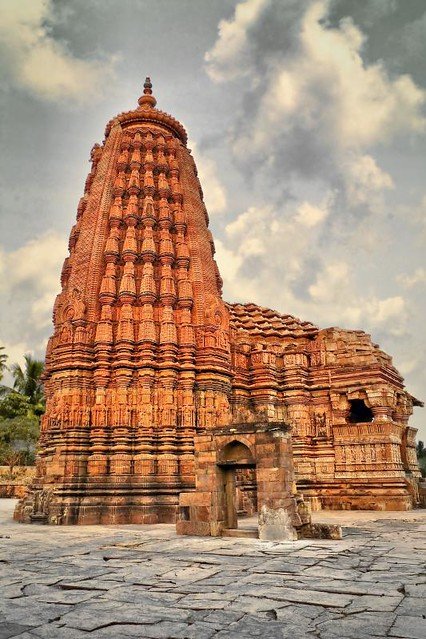
Udayeshwara Temple, Vidisha, Madhya Pradesh
In my earlier piece titled- Introduction to Indian Temple Architecture, I had delved on the fundamentals of the two prominent styles, Nagara and Dravida, of temple architecture in India.
This piece will throw light on the Nagara temple architecture style prevalent in the north of India. The Gupta Dynasty (3rd century CE to 543 CE) was the first known patron of this style which continued to be prevalent across the geography of northern India until the advent of Muslim invasions in the 13th CE. Historically from the 5th century CE to the 13thcentury CE, there was a discernible thread of continuous utilization and experimentation carried out on the basics of the Nagara style in the north and central India. In the later phase, successive and rapid invasions in this very part of the subcontinent razed thousands of the ancient and medieval temples to the ground. As a result, today one can witness only a few iconic extant specimens of this style.
The Gupta Dynasty (3rd century CE to 543 CE) was the first known patron of this style which continued to be prevalent across the geography of northern India until the advent of Muslim invasions in the 13th CE.
The Nagara style of temple architecture has a rich historical ground. Every temple present in the northern part of India, irrespective of its construction date, shows distinctively common features in planning and elevation. The temples of Nagara style generally have a square plan with a number of graduated projections in the middle of each face which give the structure a cruciform shape in the exterior. In elevation, these temple shows a tower known as Shikhara which itself is a reflection of a mountain peak, gradually inclined inwards and topped by a spheroid slab with ribs around known as Amalaka. The cruciform ground plan and curvilinear mountain-peak like tower are the two most fundamental features of Nagara style.

Ancient architectural texts like Mayatmatam, Samaranganasutradhara and Prasadamandanam refer copiously to the Nagara style of architecture and describe it in great detail. Although there are some regional variations seen in many parts of the country, Nagara style majorly has three typologies based on the shape of the Shikhara:
- Latina
- Bhumija
- Shekhari
Latina Nagara: Latina literally means made up of Lata or vine. This Nagara style has a curvilinear Shikhara with a Lata or a broad strip running in the central part from the top of the Jangha (Pilaster wall) till the Griva (top end of the superstructure) projecting a mountain peak. Examples of such temples can be seen in the region of Rajasthan, Gujarat and Madhya Pradesh prominently. Since it is the simplest form of Nagara, therefore the plan for Latina Nagara is a simple square and sometimes with a slightly staggered outline. Ghateshwar Temple, Badoli Rajasthan is one of the finest examples of this style which has a broad centre Lata running from bottom to top of the superstructure.
Ancient architectural texts like Mayatmatam, Samaranganasutradhara and Prasadamandanam refer copiously to the Nagara style of architecture and describe it in great detail.

(Source: Adam Hardy, The Temple Architecture of India, 2007, John Willey& Sons Ltd., England)
Bhumija Nagara: Bhumija simply means born from Bhumi i.e. earth. Bhumija Nagara has an elongated and a curvilinear Shikhara with successive arrangements of smaller Shikharas of decreasing size in ascending order till the top. So, visually it can be described as the shape of Latina Nagara having a multitude of its small-scale replicas running all over in vertical direction. Bhumija Shikhara usually makes a stellate star-shaped plan at the base. Due to the design variation, the Bhumija shikhara is not as curvilinear as the Latina type. Bhumija Shikhars can be easily seen in the region of Rajasthan, Gujarat, Madhya Pradesh and Maharashtra. Mahanaleshwar Temple, Menal, Rajasthan is one of the finest examples of Bhumija Style which has the series of small Shikhars in successive arrangements with a central broad lata.

(Source: Adam Hardy, The Temple Architecture of India, 2007, John Willey & Sons Ltd., England)
Shekhari Nagara: Shekhari can be simply defined as a cluster of peaks. Shekhari Nagara is a composite form of clustered Shikharas. In this form, multiple smaller Shikharas replicated after the main Shikhara are arranged in a designated manner to achieve the towering height. In this pattern, the replicas are arranged in such a fashion as to reflect the mountain and its sub-peaks. The temple with Shekhari Shikhara can easily achieve massive height and width. The Shekhari Nagara style is always based on a staggered square plan. Shekhari Nagara style can be easily seen in the region of Rajasthan, Gujarat, Madhya Pradesh and Maharashtra. Sahastrabahu Temple, Eklingaji, Rajasthan is a large complex showcasing the finest example of Shekhari style has a series of multiple Shikhars.
In large tracts of Rajasthan, Gujarat, and Madhya Pradesh the classical examples of Nagara temple architecture that survive are but a small percentage of the ones that survived the vagaries of history.

(Source: Adam Hardy, The Temple Architecture of India, 2007, John Willey & Sons Ltd., England)
The journey of evolution and variation present in the Nagara style of temple architecture from the days of its inception to the present day forms make for a fascinating study. These variations were the outcome of extensive experimentation carried out by scholars, architects, artisans and artists present in different centuries, on a stretched geography, and the many revivalist movements carried out for centuries after the destructions and upheavals by invaders. In large tracts of Rajasthan, Gujarat, and Madhya Pradesh the classical examples of Nagara temple architecture that survive are but a small percentage of the ones that survived the vagaries of history. Thus it becomes extremely important for us to create a sense of awareness and preservation for the rich repository of the great Nagara architectural heritage, many examples of which continue to remain understudied till today.






Excellent Information
Thank you so much ..it was a very informative article especially for people like me who has just stepped into the career of Architecture
Thanks a lot.
Sir also write about southern temples
Next article will be on the Introduction of Dravida style. Please wait for the next one.
Excellent information by Sushant Bharati.
Lovely